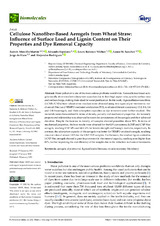Cellulose Nanofiber-Based Aerogels from Wheat Straw: Influence of Surface Load and Lignin Content on Their Properties and Dye Removal Capacity
Autor
Morcillo-Martín, Ramón
Espinosa, E.
Rabasco-Vílchez, Laura
Sánchez, Laura M.
Haro, Jorge de
Rodríguez, Alejandro
Editor
MDPIFecha
2022Materia
AerogelsDye removal
Lignocellulosic biomass
Circular economy
Biorefinery
METS:
Mostrar el registro METSPREMIS:
Mostrar el registro PREMISMetadatos
Mostrar el registro completo del ítemResumen
Water pollution is one of the most serious problems worldwide. Nanocellulose-based aerogels usually show excellent adsorption capacities due to their high aspect ratio, specific surface area and surface charge, making them ideal for water purification. In this work, (ligno)cellulose nanofibers (LCNFs/CNFs) from wheat straw residues were obtained using two types of pre-treatments: mechanical (Mec) and TEMPO-mediated oxidization (TO), to obtain different consistency (0.2, 0.4, 0.6 and 0.8) bioaerogels, and their adsorption capacities as dye removers were further studied. The materials were characterized in terms of density, porosity and mechanical properties. An inversely proportional relationship was observed between the consistencies of the aerogels and their achieved densities. Despite the increase in density, all samples showed porosities above 99%. In terms of mechanical properties, the best results were obtained for the 0.8% consistency LCNF and CNF-Mec aerogels, reaching 67.87 kPa and 64.6 kPa for tensile strength and Young’s modulus, respectively. In contrast, the adsorption capacity of the aerogels was better for TEMPO-oxidized aerogels, reaching removal rates of almost 100% for the CNF-TO5 samples. Furthermore, the residual lignin content in LCNF-Mec aerogels showed a great improvement in the removal capacity, reaching rates higher than 80%, further improving the cost efficiency of the samples due to the reduction in chemical treatments.

